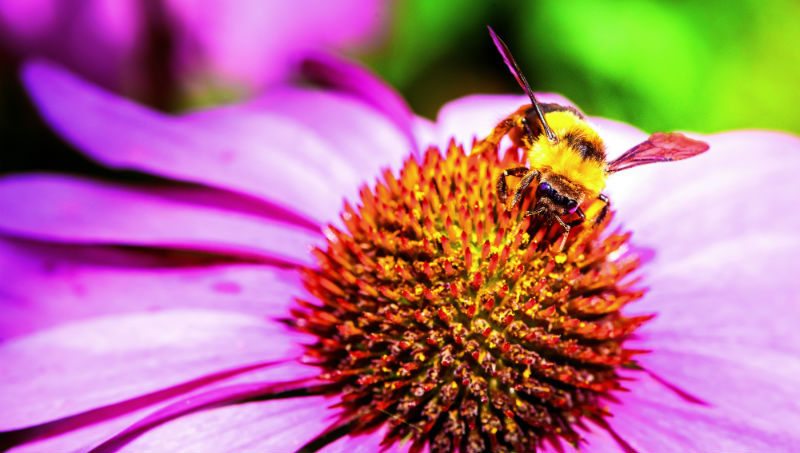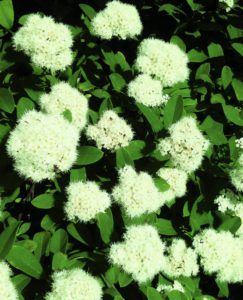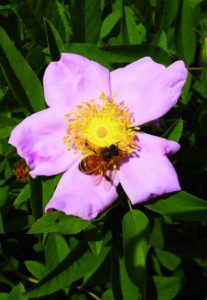
Creating Pollinator-Friendly Landscapes
The decline of pollinators, particularly bees, in North America has been making headlines for several years. Pollinators face significant threats including loss of habitat, increased parasite and disease loads, and inadvertent pesticide exposure. Urban pollinators are especially vulnerable to habitat loss and the associated loss of food resources.
Fortunately, the public is increasingly aware of this problem, and there is growing interest in planting “bee-friendly” landscapes to provide food for pollinators. Urban landscapes can provide critical resources to bees when designed and managed properly. However, landscapes dominated by monoculture grass lawns dotted with a few varieties of wind-pollinated hardwoods and conifers fall short of providing adequate nectar and pollen.
While there are many lists available in print and online that recommend bee-friendly woody ornamentals, these sources are rarely backed by scientific data and often rely on anecdotal evidence. With more than 4,000 species of native bees in North America, each with unique life histories and feeding preferences, documenting which woody ornamenatals help sustain particular types of bees can help the public make informed decisions in creating bee-friendly landscapes. In addition, publicizing such information can spur sales of such plants, benefiting growers, garden centers and landscapers.

We are wrapping up an intensive three-year survey to document bee assemblages and bee visitation rates to flowering trees and shrubs suitable for landscapes in the Ohio River Valley region. We focused on woody ornamentals because of the long-term benefits these plants can provide to bees in the urban landscape. Both native and non-native plant species were included so we could compare their usage by pollinators. We sought to identify sustainable plant species that are both bee- friendly and relatively pest-free as well as plants where bees may be at risk from insecticide exposures, i.e., plants that are both highly bee-attractive and pest-prone.
In total we sampled from 70 different species of flowering woody ornamentals at more than 350 separate sites. Sample sites included street-side and parking lot plantings, cemeteries, institutional and home landscapes, and urban arboreta within the cities of Lexington, Kentucky and Cincinnati, Ohio. We collected a sample of 50 bees from each of five sites (250 bees total) per plant species on warm, clear days during peak bloom. All specimens were identified to genus, with certain groups (e.g., bumblebees) identified to species. Before sampling, each plant was rated for bee-attractiveness based on two 30-second “snapshot” counts per site where we observed bee foraging and visitation.
Both Natives and Non-Natives are Good for Bees
Our results confirmed that different flowering ornamentals attract unique bee assemblages. Some species, e.g., flowering crabapple (Malus spp.), blue/china holly (Ilex x meserveae), eastern redbud (Cercis canadensis) and chaste-tree (Vitex agnus-castus) attract diverse assemblages of bees whereas others, such as linden (Tilia spp.) and mockorange (Philadelphus spp.), attract fewer, sometimes specialist species.
One of the key questions was: “Are natives and non-natives equally bee-attractive?” We observed similar ranges of snapshot counts in each group and found that plants within both groups can be highly attractive to bees. Additionally, some non-native species, e.g., seven-son flower (Heptacodium miconioides), chaste-tree, and glossy abelia (Abelia x grandiflora), bloom in mid- to late summer and provide valuable floral resources for bees well after many native species have finished producing nectar and pollen.
Flower Form Matters

We observed that flower form plays a significant role when it comes to bee-attractiveness. Open flowers with easily accessible nectar and pollen, such as climbing rose (Rosa setigera), summersweet (Clethra alnifolia), and peegee hydrangea (Hydrangea paniculata), are more attractive and provide more resources to bees than double flowers such as hybrid tea roses and Kanzan cherry (Prunus serrulata ‘Kanzan’), or plants with showy sterile florets such as bigleaf hydrangea (Hydrangea macrophylla). Plants that provide little pollen or nectar, such as flowering dogwood (Cornus florida), were observed to have low bee visitation during snapshot counts. However, this does not necessarily mean that these plants do not support bees. In fact, we managed to get several 50-bee samples from flowering dogwood sites despite low visitation, but it took much longer compared to plant species that had higher bee-attractiveness.
Bees Need Season-Long Resources
One of the most important factors in creating a bee-friendly landscape is providing season- long food resources. Many of our native bees, such as orchard bees, bumblebees, and digger bees, emerge early in the spring and rely on early bloomers to start their colonies. Some of our early season standouts include trees such as eastern redbud, Cornelian cherry (Cornus mas), Higan cherry (Prunus subhirtella ‘autumnalis’) and flowering crabapple, while winter honeysuckle (Lonicera fragrantissima) and dwarf fothergilla (Fothergilla gardenii) are good choices for early blooming shrubs.
There is a wealth of bee- attractive plants that bloom during mid-season when bee populations are at their peak, and some of our favorites are common winterberry (Ilex verticillata), linden, St. John’s wort (Hypericum frondosum) and golden raintree (Koelreuteria reticulata). Mid-season shrubs such as bottlebrush buckeye (Aesculus parviflora), Japanese tree lilac (Syringa reticulata) and Virginia spiraea (Spiraea virginiana) attract not only a diverse range of bees but also many other types of pollinators including butterflies and flower flies.
Late-season bloomers are a bit scarcer, with species like summersweet, bee bee tree (Tetradium daniellii), peegee hydrangea, sweetspire (Itea virginica) and winged sumac (Rhus copallinum) blooming from July to August. Only a few woody ornamentals bloomed past August. However, the ones we surveyed, like glossy abelia or seven-son flower, were highly bee-attractive. Late-season blooming trees and shrubs are particularly valuable because they provide food to bumblebees, honeybees and sweat bees at a time when other floral resources are relatively scarce.
Creating Diverse, Pest-Free Landscapes

Throughout our study we made sure to survey ubiquitous woody ornamentals such as azaleas, boxwoods, lindens and hybrid tea roses. A number of those species also have serious pests and diseases associated with them, which make them prime targets for pesticide applications.
Fortunately, some “buggy” species, e.g., azaleas, boxwoods and hybrid tea roses, attract few to no bees and do not pose a significant threat to bees if treated with insecticides. However, there is a relatively small subset of highly bee-attractive species, e.g., lindens, flowering crabapples, hawthorns and single-petalled roses that have key insect pests which often need to be controlled.
The use of systemic insecticides should be avoided on such “bee magnets” because of the risk of residues contaminating pollen and nectar. When treating for pests on such plants, using pesticides with short residuals or low intrinsic bee toxicity (e.g., Acelepryn) is a reasonable Best Management Practice (BMP) for safeguarding bees and other pollinators.
Another way to reduce the hazard of pesticide exposure to bees is to diversify urban landscapes by planting pest- free, underutilized bee-attractive species in lieu of overplanted, pest-prone species. Species such as Cornelian cherry, seven-son flower, Amur maackia (Maackia amurensis), Devil’s walking stick (Aralia alata), buttonbush (Cephalanthus occidentalis) and Virginia spiraea are examples of bee-friendly plants that have few or no major insect pests but are relatively rare within the urban landscape. Promoting these types of plants, instead of continuing to use the same overutilized, “buggy” species, could reduce the use of pesticides in the urban landscape and create a healthier, less hazardous environment.
For more information and a more complete list of bee-attractive woody ornamentals, please visit https://entomology.ca.uky.edu/person/bernadette-mach. Acknowledgment: This research was partially funded by NIFA-SCRI grant 2016-51181-25399, as well as Horticultural Research Institute and Bayer North American Bee Care Center.


 Video Library
Video Library 




















